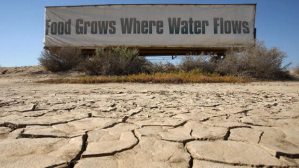The Costs of the California Drought
 The ongoing drought in California is raising concerns that this year’s fire season could be the worst on record. It’s also pitting farmers against environmentalists over who should be able to use how much of the state’s scarce water supply.
The ongoing drought in California is raising concerns that this year’s fire season could be the worst on record. It’s also pitting farmers against environmentalists over who should be able to use how much of the state’s scarce water supply.
A report by the University of California, Davis’ Center for Watershed Sciences contends that the drought could result in more than 14,000 jobs being lost and the state’s GDP to decline by over $850 million this year, as farmers are forced to leave fields fallow due to the absence of water. Central Valley farmers are demanding the state bypass water usage restrictions that mandate a minimum level of flow to protect fish in the state’s rivers and bays, and divert water to farms for food production instead. Environmentalists assert that the suspending the minimum flow requirements would pose threats to several fish and bird species on the Endangered Species List.
The drought’s impact will not be limited to California. A study by Arizona State University concluded that the entire United States will likely see sharp increases in the price of avocados (projected to increase 28 percent his summer) and lettuce (projected to jump 34 percent). Price increases were also forecast for berries, broccoli, grapes, peppers, and tomatoes, and a wide variety of nuts.
California is responsible for about half the fruits and vegetables grown in the United States. As the short-term methods for coping with the drought are exhausted, food production will likely decline, and food prices will increase.
But even more alarmingly, long-term models suggest that this kind of drought will become increasingly common as climate change continues. It’s a bleak picture for the future of food.
it’s critical that other areas that have dropped support for local fruit and vegetable production get to work to rebuild and regrow the sector — a great assignment for a regional food policy council; California needs its limited water to feed itself.
The way we produce food and what crops we can grow is going to have to change to adjust to ongoing climate change which will only become more challenging in the future. Another issue is to rethink the current farming/conservation model and try to approach it in a way that the two are integrated and not separate.
Reblogged this on Sahel Green Food.